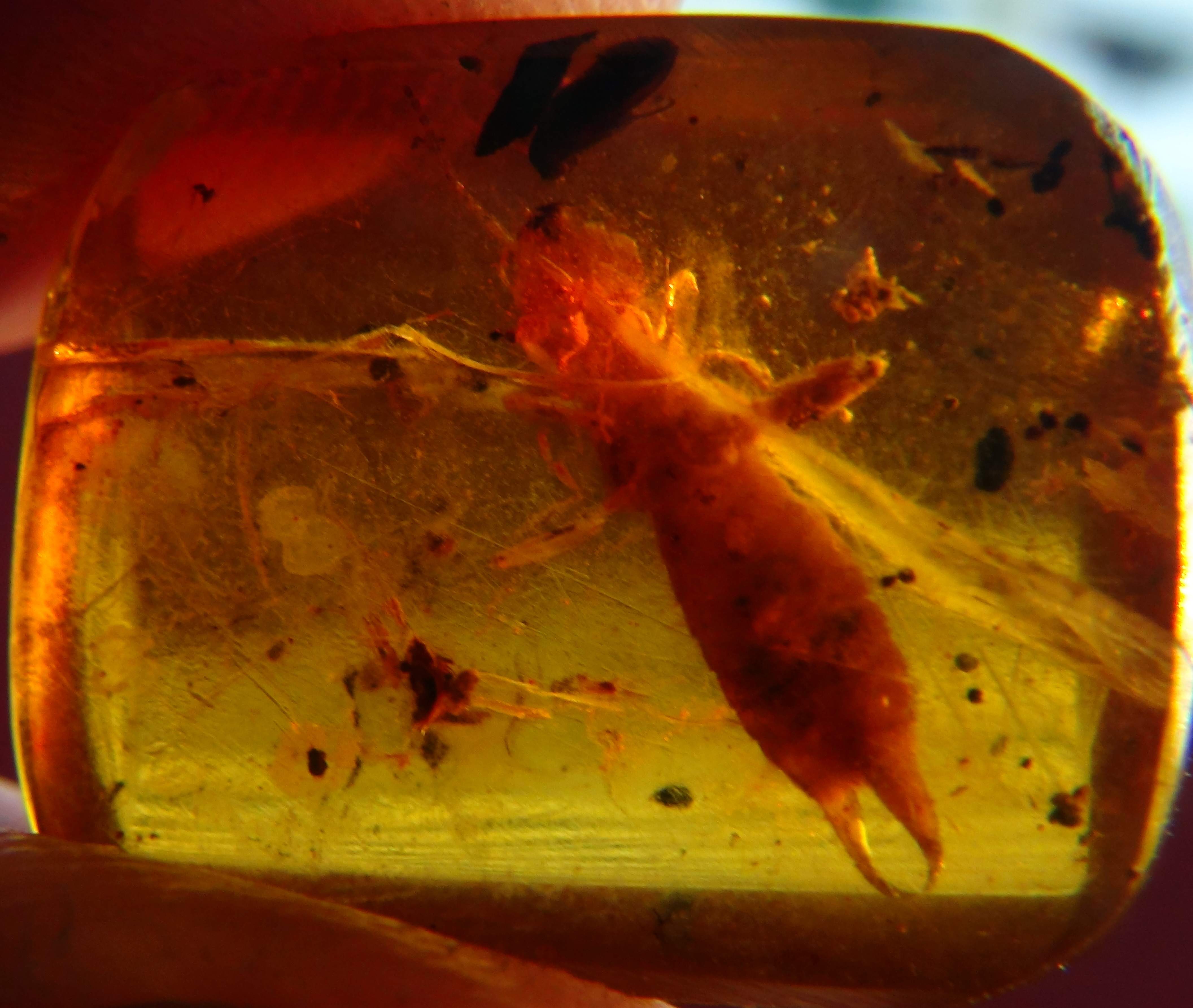Earwigs make up the insect order Dermaptera. With about 2,000 species in 12 families. Earwigs have characteristic cerci, a pair of forceps-like pincers on their abdomen, and membranous wings folded underneath short, rarely used forewings, hence the scientific order name, "skin wings". Some groups are tiny parasites on mammals and lack the typical pincers. Earwigs are found on all continents except Antarctica.

7 Members of the Earwig Family found in Burmite
HEXAPODA
Dermaptera (4f., 7g., 7sp.)
Anisolabididae?
Toxolabis zigrasi Engel & Grimaldi, 2014
Diplatyidae
Tytthodiplatys mecynocercus Engel, 2011
Labiduridae
Myrrholabia electrina (Cockerell, 1920)
Zigrasolabis speciosa Engel & Grimaldi, 2014
Pygidicranidae
Astreptolabis ethirosomatia Engel, 2011
Burmapygia resinata Engel & Grimaldi, 2004
Stonychopygia leptocerca Engel & Huang, 2016
Some scientific papers written on earwigs in Myanmar amber
Engel, M.S. 2011. New earwigs in mid-Cretaceous amber from Myanmar (Dermaptera, Neodermaptera). Zookeys, 130, 137-152.
Earwigs are certainly one of the lesser-studied lineages of insects, with comparatively few current investigations underway into their diversity, behavior, biology, and general natural history. This is unfortunate given the remarkable diversity of form for these often subsocial insects, with their prominent and immediately recognizeable cercal forceps which are used in aggressive/defensive interactions, courtship, and prey capture (e.g., Günther and Herter 1974; Briceño and Eberhard 1995; Haas 2003; Costa 2006; Rankin and Palmer 2009). The systematics of the group was once the concerted interest of dermapterological luminaries such as Malcolm Burr (1876–1954), Walter D. Hincks (1906–1961), and Allan Brindle (1915–2001) but has not received quite as much effort in recent years and the sizeable monographs that were once regularly flowing from earwig taxonomists has slowed. Ironically, paleontological investigation into earwigs has seen a reversed trend, with increasingly more and more accounts during the last decade (e.g., Nel et al. 2003; Wappler et al. 2005; Chatzimanolis and Engel 2010; and additional citations below). Of particular interest have been the numerous new records of Mesozoic Dermaptera which have come to light, mostly as compression fossils from Asia (e.g., Zhang 1997; Engel et al. 2002; Zhang 2002; Zhao et al. 2010a, 2010b, 2011) or South America (Engel and Chatzimanolis 2005; Haas 2007), but also including a steadily accumulating number of amber inclusions (e.g., Engel and Grimaldi 2004; Engel 2009; Perrichot et al. 2011; Engel et al. 2011).
Engel, M.S. & Grimaldi, D.A. 2004. A primitive earwig in Cretaceous amber from Myanmar (Dermaptera: Pygidicranidae). Journal of Palaeontology, 78(5), 1018-1023.
Engel, M.S., Huang, D., Thomas, J.C. & Cai, C. 2016 (on-line). A new genus and species of pygidicranid earwigs from the Upper Cretaceous of southern Asia (Dermaptera: Pygidicranidae). Cretaceous Research, 69, 178-183.Engel, M.S. & Grimaldi, D.A. 2014a. New mid-Cretaceous earwigs in amber from Myanmar (Dermaptera). Novitates Paleoentomologicae, No. 6, 16pp.
Engel, M.S. & Grimaldi, D.A. 2004. A primitive earwig in Cretaceous amber from Myanmar (Dermaptera: Pygidicranidae). Journal of Palaeontology, 78(5), 1018-1023.
Zhao, X., Zhang, Q., Jarzembowski, E.A., Chen, L. & Wang, B. 2016. A new earwig fly from mid-Cretaceous Burmese amber (Mecoptera: Meropeidae). Cretaceous Research, 66, 136-140.



